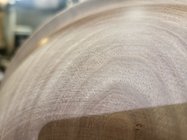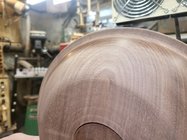Lots of deep inline scratches. Are you sure your student took care to keep the sandpaper moving, speaking of hand held pad. The grit will carve into the wood if held still.
When power sanding, be careful not to use the wrong side of the spinning disk. So, sanding the outside, as you’re showing, only the left side of the disk can touch, the side going against the direction of rotation. The right side, going with the rotation will put nasty swirly scratches. Also swinging around toward the midpoint of the bowl, you will be using more of the top and left side of the disk. Running perpendicular to the rotation is ok. Stay away from the center of the disk. To power sand near the bottom of the bowl, you need to reverse the direction of the piece or of the sander, to be sanding again against the rotation.
The best, and only way I’ve found to avoid the issue of dropping back two or more grades after finding ‘new’ scratches is to sand alternately by hand holding paper, and power sanding. Sand handheld (I sand at 750), you should start at 120 given the look of those marks. Inspect it carefully. The ONLY scratches must be inline! Zero swirls. None. Look close with a raking light.
Then, sand by power, the goal being to simply eliminate all of the in-line scratches. Sand with the same grit as handheld. All scratches must be swirls or random looking. Again, look very closely with a raking light.
Personally, I continue this process through at least 800,,usually to 2000. No surprises when the sun hits it!



